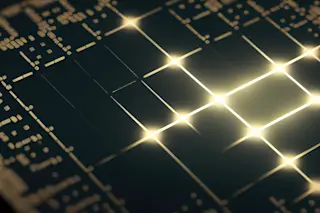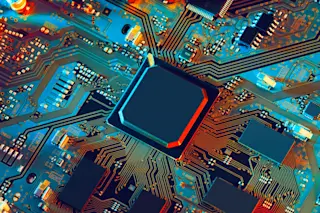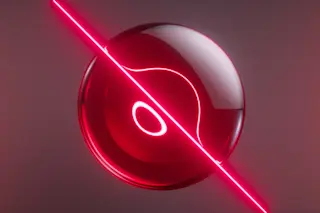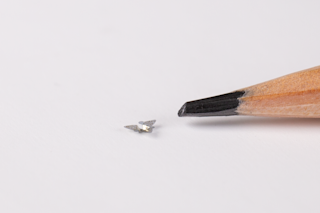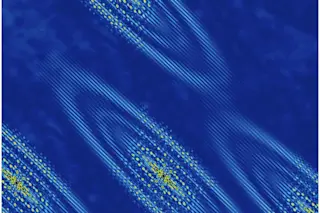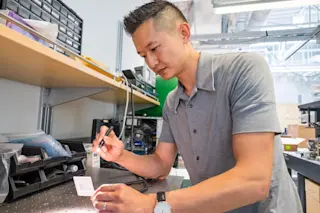In the 1960s, physicists showed how light could interact with itself in intriguing ways thanks to a process known as second-harmonic generation. In the right kind of material, two photons of a certain frequency can interact to produce another photon of twice the frequency, turning red light into green, for example. Since then, physicists have exploited these non-linear optics in techniques ranging from precision measurement to quantum computing.
Yet, one persistent challenge has remained. Nonlinear optical devices must be crafted with a single, unchangeable function determined during fabrication. And this limits their utility and function.
Now that looks set to change thanks to the work of Ryotatsu Yanagimoto at Cornell University in Ithaca, and colleagues, who have unveiled a programmable photonic chip that promised to reshape optical science and the technology it enables.
Sculpted Light
A key process in non-linear optics is phase matching—the ability to synchronize two different light waves to keep them in phase. Ordinary materials do not usually allow this in their raw state and so must be carefully "sculpted" through complex nanofabrication processes.
One example is to grow patterns of semiconductor material on the surface to form a grating that forces light of a certain wavelength to interact in a nonlinear way. This allows laser light to interact with the electrons inside the material in a nonlinear way that keeps their phases in sync. This is known as a χ(2) effect.
However, this pattern is fixed, as is the type of interactions the material allows and any potential applications.
Yanagimoto and co's breakthrough circumvents these limitations. They have found a way to induce the same kinds of changes in a material using an external light field. So by beaming a pattern of light onto the material, it can create the same kind of χ(2) effect.
This ingenious mechanism allows the team to create versatile phase-matching gratings that are customizable in real-time. ”This allowed us to create distinct spatial light profiles across multiple wavelengths,” say the team.
The underlying mechanics involve a slab waveguide composed of a silicon nitride core, a photoconductive silicon-rich nitride layer, and an indium tin oxide electrode. When illuminated by structured green laser light, the photoconductive layer becomes locally conductive, inducing a programmable nonlinearity.
In one demonstration, Yanagimoto and co used the technique to spell out the name "Cornell" in second-harmonic light over time. They achieved this by using structured illumination on the photoconductive layer, selectively activating the electric-field-induced nonlinearity across the chip's surface. When the bias voltage was applied, these illuminated regions became active, generating second-harmonic light at twice the frequency of the input laser beam but modulated over time in a way that spelt out the name of the university.
This adaptability should open the floodgates for various applications. For instance, programmable nonlinear photonic chips could enable sophisticated quantum computing architectures, allowing a single device to execute multiple quantum gates or generate quantum states tailored to specific computational tasks.
The chips also promise significant advancements in classical optical communications, enabling ultra-fast all-optical signal processing and reconfigurable optical computation. “Our work shows that we can transcend the conventional one-device–one-function paradigm,” say Yanagimoto and co.
The team also developed real-time feedback techniques that allow them to produce small changes in output as needed. This allows them to address one of the longstanding issues with traditional nonlinear optical techniques: fabrication imperfections. Traditional components are notoriously sensitive to minor imperfections which can drastically affect performance. But the real time adaptability sidesteps this challenge by dynamically compensating for these variations, greatly enhancing reliability and yield.
Practical Applications
The Cornell team's device is still in an early developmental stage. Its current nonlinearity strength, while modest, can potentially be increased by a factor of ten or even one hundred through further engineering refinements, say Yanagimoto and colleagues. Such improvements should help propel this technology from the laboratory bench to practical use.
Reflecting on their achievement, Yanagimoto and co say the work paves the way toward a future where optical devices are not merely passive conduits but active participants, dynamically responding to the demands of their environments and users. This development signifies a new era in optics, one where adaptability and programmability are fundamental rather than exceptional.
Ref: Programmable on-chip nonlinear photonics : arxiv.org/abs/2503.19861


